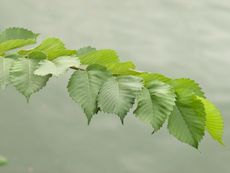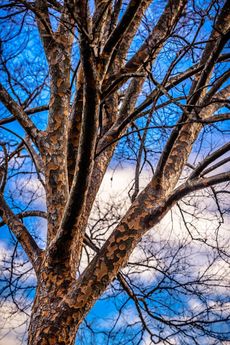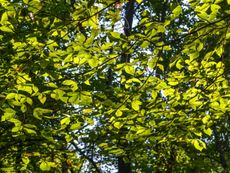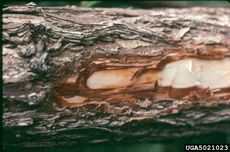Dutch Elm Protection - Is There Treatment For Dutch Elm Disease


Elm trees once lined city streets all across America, shading cars and sidewalks with their enormous, outstretched arms. By the 1930's, though, Dutch elm disease had arrived on our shores and began destroying these favorite trees of Main Streets everywhere. Although elms are still popular in home landscapes, American and European elms are highly susceptible to Dutch elm disease.
What is Dutch Elm Disease?
A fungal pathogen, Ophiostroma ulmi, is the cause of Dutch elm disease. This fungus is spread from tree to tree by boring beetles, making Dutch elm protection difficult at best. These tiny beetles burrow under the bark of elms and into the wood beneath, where they tunnel and lay their eggs. As they chew through the tree's tissues, the fungal spores are rubbed off onto tunnel walls where they germinate, causing Dutch elm disease.
How to Detect Dutch Elm Disease
Signs of Dutch elm disease come on rapidly, over about a month's time, typically in the spring when leaves are just maturing. One or more branches will be covered in yellow, wilted leaves that soon die and fall from the tree. As time goes on, the disease spreads to other branches, eventually consuming the whole tree. Positive identification based on symptoms alone can be difficult because Dutch elm disease mimics water stress and other common disorders. However, if you cut open an affected branch or twig, it will contain a dark ring hidden in the tissues below the bark --this symptom is caused by fungal bodies clogging up the tree's transport tissues. Treatment for Dutch elm disease requires a community-wide effort to successfully eradicate both the beetles and fungal spores they carry. A single, isolated tree may be saved by pruning out affected branches and treating bark beetles, but multiple trees affected by Dutch elm disease may require removal in the end. Dutch elm disease is a frustrating and costly disease, but if you absolutely must have elms in your landscape, try the Asian elms --they have high levels of tolerance and resistance to the fungus.
Gardening tips, videos, info and more delivered right to your inbox!
Sign up for the Gardening Know How newsletter today and receive a free download of our most popular eBook "How to Grow Delicious Tomatoes."

Kristi Waterworth was a regular contributor to Gardening Know How for many years, answering countless queries on plant pests and diseases.
-
 How To Grow Garden To Table: A Guide For Home Cooks
How To Grow Garden To Table: A Guide For Home CooksWhat could be better than a meal that comes directly from garden to table? Show off your gardening and culinary skills with the very freshest food.
By Bonnie L. Grant
-
 Want a Backyard Mini Orchard? Create Your Own Container Orchard
Want a Backyard Mini Orchard? Create Your Own Container OrchardEasier to care for in small spaces, a backyard mini-orchard makes sense for busy gardeners and juicy fruit is the reward.
By Teo Spengler
-
 What Is An American Elm Tree - American Elm Facts
What Is An American Elm Tree - American Elm FactsThe beautiful American elm tree is probably not the best choice for your landscape. This lovely deciduous tree is sadly vulnerable to Dutch elm disease, and is not recommended by experts.
By Teo Spengler
-
 Rock Elm Tree Identification – What Does A Rock Elm Tree Look Like
Rock Elm Tree Identification – What Does A Rock Elm Tree Look LikeThe rock elm is one of the six elm trees native to the United States. Click here to learn more about the rock elm tree.
By Laura Miller
-
 Lacebark Elm Information – Care Of Chinese Lacebark Elm In Gardens
Lacebark Elm Information – Care Of Chinese Lacebark Elm In GardensAlthough lacebark elm is native to Asia, it was introduced to the United States in 1794. Since that time, it has become a popular landscape tree, suitable for growing in USDA hardiness zones 5 through 9. Find more lacebark elm information here.
By Mary H. Dyer
-
 Slippery Elm Information: Tips On Using And Growing Slippery Elm Trees
Slippery Elm Information: Tips On Using And Growing Slippery Elm TreesSlippery elm bark contains a substance that becomes slick and slippery when mixed with water, hence the name. The tree has been used in herbal medicine in this country for centuries. For more information about slippery elm herb uses, click this article.
By Teo Spengler
-
 What Is A Camperdown Elm Tree: Camperdown Elm History And Information
What Is A Camperdown Elm Tree: Camperdown Elm History And InformationIf you are familiar with Camperdown elm, you are surely a fan of this lovely tree. If not, you may ask: "What is a Camperdown elm tree?". In either case, click this article for more information, including Camperdown elm history.
By Teo Spengler
-
 Japanese Elm Tree Care: How To Grow A Japanese Elm Tree
Japanese Elm Tree Care: How To Grow A Japanese Elm TreeBecause of Dutch Elm disease, many people opt for Japanese elm trees instead, which are hardier and equally attractive. This article provides Japanese elm tree facts, including information about how to grow a Japanese elm tree.
By Teo Spengler
-
 Elm Phloem Necrosis – Methods Of Elm Yellows Treatment
Elm Phloem Necrosis – Methods Of Elm Yellows TreatmentElm yellows is a disease that attacks and kills native elms. The disease is systemic and lethal. Learn about the symptoms of elm yellow disease and whether there is any effective elm yellows treatment in this article. Click here for more info.
By Teo Spengler
-
 Drake Elm Tree Growing: Tips On Caring For Drake Elm Trees
Drake Elm Tree Growing: Tips On Caring For Drake Elm TreesThe drake elm (also called Chinese elm or lacebark elm) is a quick-growing elm tree that naturally develops a dense, rounded, umbrella-shaped canopy. For more drake elm tree information and details on caring for drake elm trees, click this article.
By Teo Spengler